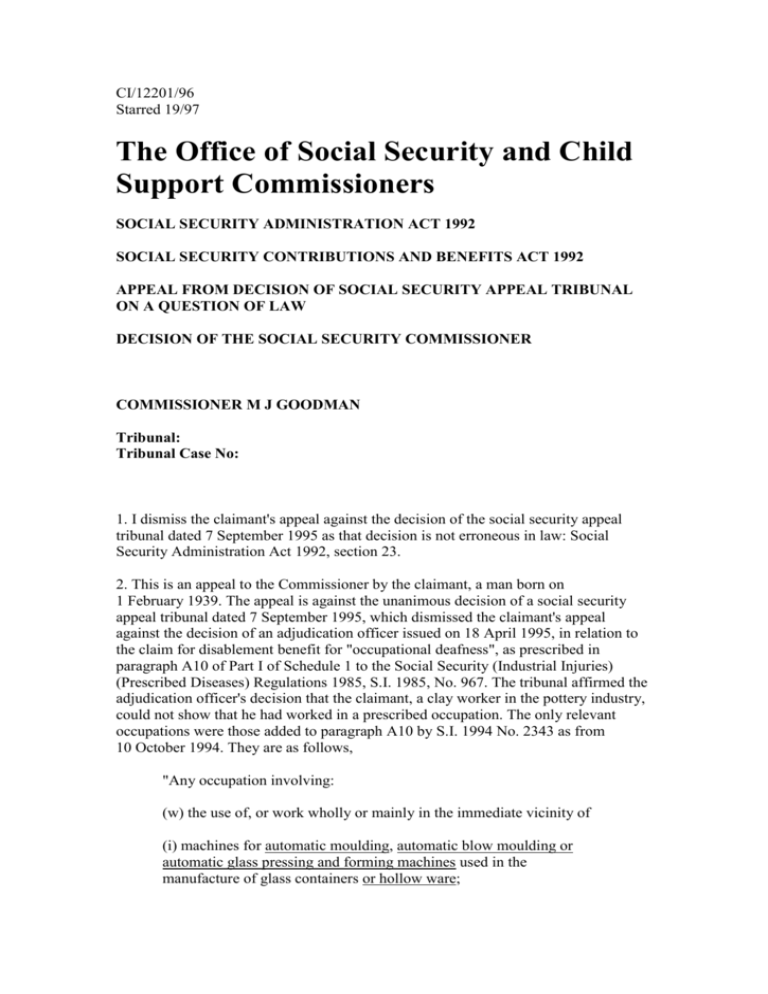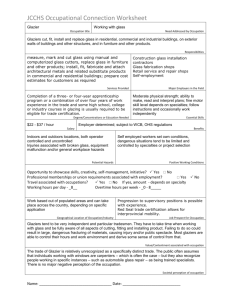The Office of Social Security and Child Support
advertisement

CI/12201/96 Starred 19/97 The Office of Social Security and Child Support Commissioners SOCIAL SECURITY ADMINISTRATION ACT 1992 SOCIAL SECURITY CONTRIBUTIONS AND BENEFITS ACT 1992 APPEAL FROM DECISION OF SOCIAL SECURITY APPEAL TRIBUNAL ON A QUESTION OF LAW DECISION OF THE SOCIAL SECURITY COMMISSIONER COMMISSIONER M J GOODMAN Tribunal: Tribunal Case No: 1. I dismiss the claimant's appeal against the decision of the social security appeal tribunal dated 7 September 1995 as that decision is not erroneous in law: Social Security Administration Act 1992, section 23. 2. This is an appeal to the Commissioner by the claimant, a man born on 1 February 1939. The appeal is against the unanimous decision of a social security appeal tribunal dated 7 September 1995, which dismissed the claimant's appeal against the decision of an adjudication officer issued on 18 April 1995, in relation to the claim for disablement benefit for "occupational deafness", as prescribed in paragraph A10 of Part I of Schedule 1 to the Social Security (Industrial Injuries) (Prescribed Diseases) Regulations 1985, S.I. 1985, No. 967. The tribunal affirmed the adjudication officer's decision that the claimant, a clay worker in the pottery industry, could not show that he had worked in a prescribed occupation. The only relevant occupations were those added to paragraph A10 by S.I. 1994 No. 2343 as from 10 October 1994. They are as follows, "Any occupation involving: (w) the use of, or work wholly or mainly in the immediate vicinity of (i) machines for automatic moulding, automatic blow moulding or automatic glass pressing and forming machines used in the manufacture of glass containers or hollow ware; (ii) spinning machines using compressed air to produce glass wool or mineral wool; (iii) continuous glass toughening furnaces." (my underlining). 3. The appeal was the subject of an oral hearing before me on 28 January 1997 at which the claimant was not present but was represented by Mr M Lawson-Jones, a Welfare Rights Officer of the relevant County Council. The adjudication officer was represented by Mr Sriskandarajah of the Office of the Solicitor to the Departments of Health and Social Security. I am indebted to Mr Lawson-Jones and Mr Sriskandarajah for their assistance to me at the hearing. 4. The facts are shortly these. On 6 March 1995, the claimant made a claim to disablement benefit for Prescribed Disease A10 (Occupational Deafness). He stated that he was a "clay worker" and was still on the books of his employer. Mr LawsonJones told me at the hearing that the claimant operated a forming machine, used in the manufacture of ceramic (pottery) hollow ware, but not glass hollow ware. A forming machine is not the same as a pressing machine. 5. The adjudication officer sent a Form of enquiry to the employers. In answer to the question on the Form whether the claimant used or worked close to someone using, "automatic moulding, blow moulding and glass pressing and forming machines used in the manufacture of glass containers and hollow ware", the employer answered "No". It should be noted, however, that the prescribed occupation was misquoted on the Form. I have underlined the word "and" but the word in fact used in the prescribed occupation is not "and" but "or". Whether that influenced the employer's answer I do not know. 6. The claimant appealed to the social security appeal tribunal but he was not present. His representative (Mr Lawson-Jones) said, "Claimant was employed in pottery industry. I contend he was making hollow ware which includes metal and ceramics as well as glass." The presenting officer submitted, "[In the prescribed occupation] hollow ware is qualified by adjective glass as well as containers and the whole of paragraph (w) is related to glass industry. There is no argument about the types of machines he was using.". 7. The tribunal in dismissing the appeal gave the following reasons, "Although the drafting is a little ambiguous, the tribunal is satisfied that the adjective 'glass' qualifies both 'containers' and 'hollow ware', and the complete paragraph related entirely to the glass industry. No other [prescribed occupation] applies. The claimant has not, therefore, worked in a qualifying occupation." Although those reasons are fairly short they do seem to me accurately to deal with the issues in question (see below). 8. Mr Lawson-Jones cites the definition of "hollow ware" from the Shorter Oxford English Dictionary (among other Dictionaries) as, "hollow articles of wood, china, or especially metal, as pots, kettles etc. Opposite - flat ware." He also draws attention to the fact that paragraph (w)(i) of paragraph A10 uses the word "or" and not the word "and" in the expression, "... used in the manufacture of glass containers or hollow ware". He submits that the word "or" is used disjunctively and moreover that the word "glass" relates only to the word "containers" and does not qualify or relate to the words "hollow ware". 9. Mr Sriskandarajah contends otherwise and argues that, looked at at its entirety, (apart from mineral wool) paragraph (w) relates only to the glass industry - compare sub-paragraphs (ii) and (iii). He also cites the report of the Industrial Injuries Advisory Council (1994 - Cm. 817) which led to the introduction of the new prescribed occupations. Before I deal with the Council's report, it must be borne in mind that the claimant is entitled to any benefit which the law gives him in the shape of the actual wording of para. A10 of Schedule 1 to the Prescribed Diseases Regulations. If that wording is clear and unambiguous, then the material in the Advisory Council's Report cannot be used to qualify it or alter its meaning. If, however, that wording is unclear or ambiguous, the Council's Report may be used to clarify it. (see Black-Clawson International Ltd. v Papierwerke WaldhofAschaffenburg A.G. [1975] A.C. 951, House of Lords). 10. I now deal with the relevant parts of the Advisory Council's Report. At section IV (headed "The evidence - the glass industry") there is a reference to the Council's Special Adviser visiting "a number of glass product manufacturers" and making measurements of the noise associated with various occupations (which are now listed in the prescribed occupation). Paragraph 7 of that section notes that "all methods of forming hollow ware produce levels of noise above 90dB(A)." and adds "where there was excessive noise it was due, in the main, to the use of jets of compressed air to cool the glass or the moulds." Paragraph 7 then goes on to observe, "noise levels above 90 dB(A) were not found in either the float glass or the traditional methods of producing sheet glass.". 11. The Council then recommended that the prescription for occupational deafness be extended to include, to quote their recommendation, (a) Work in the manufacture of glass and mineral products involving the following processes and machines, or work wholly or mainly in the vicinity of such machines; (1) machines for automatic moulding, blow moulding, or glass pressing and forming machines used in the manufacture of glass containers and hollow ware. ....... " (my underlining). 12. It will be seen at once that there are two significant differences between that recommendation and the prescribed occupation(s) as ultimately inserted into the 1985 Regulations. The first difference is that the whole of the recommended prescription is made to relate to "work in the manufacture of glass and mineral wool products". That limitation does not occur in the actual prescription in paragraph (w) of paragraph A10 in the 1985 Regulations. Secondly in the part with which we are now concerned in the expression "forming machines used in the manufacture of glass containers and hollow ware" the word used is "and" and not the word "or", which is used in the prescribed occupation. 13. Having considered all these matters and the able arguments put to me at the oral hearing, I have come to the conclusion in this difficult case that, although the claimant is entitled to the benefit of the actual words used in the prescription, that prescription is (apart from mineral wool) confined to glass manufacture. The words, " ... forming machines used in the manufacture of glass containers or hollow ware" do in my view read in such a way that the adjective "glass" applies not only to "containers" but also to "hollow ware". That is the natural meaning of the sentence and it also coincides with the fact that the rest of sub-paragraphs (i) and (ii) and (iii) of paragraph (w) are all clearly confined to the manufacture of various kinds of glass (save "mineral wool" in sub-paragraph (ii)). The report of the Advisory Council leads to the same conclusion and I am entitled to look at its contents in view of the ambiguity introduced in paragraph (i) of paragraph (w) by the use of the word "or" between "glass containers" and "hollow ware". Overall, therefore, I am satisfied that the tribunal arrived at the correct decision and that the prescribed occupation in paragraph (w) of paragraph A10 is not intended to apply to any kind of hollow ware except that made of glass. I must therefore dismiss the claimant's appeal accordingly. (Signed) M J Goodman Commissioner (Date)






